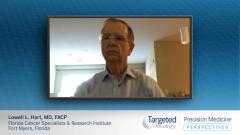
EP. 8A: Considerations for Reactive and Proactive Approaches to the Management of Chemotherapy-Induced Myelosuppression in Extensive-Stage Small Cell Lung Cancer
In the fourth interview of the series, Dr. Estelamari Rodriguez from the University of Miami Health System considers unmet needs in extensive-stage small cell lung cancer and discusses the role of reactive and proactive approaches to the management of chemotherapy-induced myelosuppression.
Episodes in this series

[With] regard to SCLC, which we all know is a rapidly growing type of cancer, when we meet patients, most of them will have ES-SCLC, [so] it is very critical to start treatment rapidly and to stay on schedule. Myelosuppression is a big unmet need in SCLC because we have a lot of patients [who] have bone marrow involvement at the time of diagnosis. They present with cytopenias to begin with or they develop cytopenias very quickly, [which] leads to delays in treatment.
CIM in SCLC is very common, and traditionally we have monitored patients closely and transfused them when they needed transfusion. But the biggest problem of myelosuppression is the occurrence of neutropenic fever. When possible, we like to be proactive about that because it can lead to admissions to the hospital in patients that are already very sick, and it can lead to delays in their treatment.
What we usually do, especially if they are older patients [who] may have some underlying bone marrow myelodysplasia [and] their bone marrow really wouldn't be able to handle the chemotherapy, [is] use growth factors. We have growth factors that are used after the treatment when you find the occurrence of neutropenia, and that's more like a reactive approach. And then there's a more proactive approach where you either introduce an agent at the beginning of the chemotherapy to prevent neutropenia or 24 hours after. There [are] 2 major classes that are approved and used. One [is] traditional pegfilgrastim, which is a growth factor that is used after chemotherapy, and the other one is trilaciclib, which is a cyclin-[dependent kinase 4/6] inhibitor that has data in preventing myelosuppression in the treatment of ES-SCLC.
In terms of myelosuppression in the treatment of extensive-stage cell lung cancer, we have 2 issues. One is that patients present with cytopenias at baseline in many cases because they have extensive disease that involves the bone marrow. The other issue is that there tend to be older patients [who] will already have poor tolerance to chemotherapy [such] that neutropenia would lead to dose reductions [and] potential admissions to the hospital. Ultimately, our goal is to treat these patients rapidly and effectively and to be able to offer them additional treatment if they fail the initial treatment. It is very important to maintain their bone marrow to let their bone marrow recover so that we can offer them these treatment options.
Some of the new agents like trilaciclib will also allow you to prevent other myelosuppression in terms of the white blood cell lineage [and] the red cell lineage in addition to platelets. That has sometimes been an issue [when] patients get treated, and then we can’t restart the treatment because they have thrombocytopenia, and they require transfusions. With thrombocytopenia, it's very difficult to even move to the second-line treatment, so a medication that you can start from the beginning of the treatment that will prevent myelosuppression would allow those patients to have a healthier bone marrow throughout the journey of their treatment. I think—specifically these drugs that prevent thrombocytopenia—have a very important role, so that you can proactively prevent transfusions in these patients. I think what is more critical for us is that we avoid delays of treatment and dose reductions in patients [who] have [the] very rapidly aggressive disease of SCLC.
In SCLC—where really staying on schedule and starting patients on treatment early is critical—there [are] very [few] drawbacks in terms of being proactive about preventing myelosuppression because the benefits are so great. I think the potential drawback is that you're introducing another medication with another cost—another medication that could lead to injection site reactions or a hypersensitivity reaction, which are very rare. Those would be potential added risks to the patients, but the benefits are really overwhelming for patients with SCLC who are so ill, who present so sick. [It] is really critical that they stay on schedule [and] that we decrease the burden of disease. In my practice, having treatments that allow us to keep these patients on schedule and complete all the treatment is critical.
Transcript has been edited for clarity.


















































